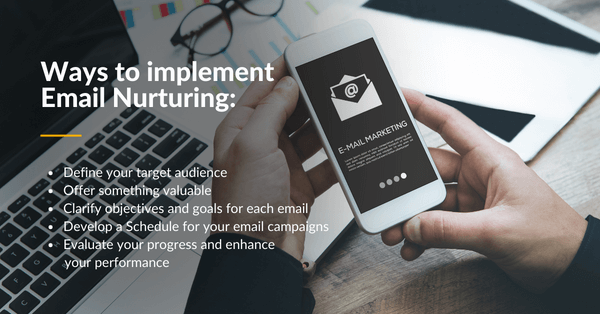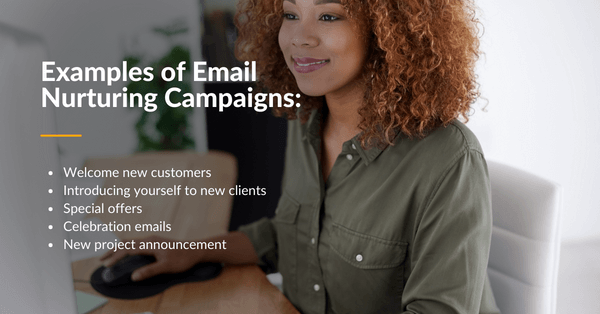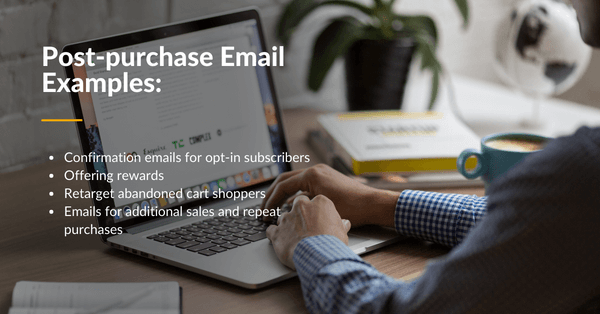Nurturing Campaigns. A new client can make or break your business. But how do you go about building long-lasting relationships with them? You need to nurture them and then convert them into a sale. This is where email nurturing campaigns come into place. They help you stay engaged with your clients by laying the groundwork for your next step in the sales funnel. Here we look at what email nurturing campaigns are and how they can help you stay engaged with clients that are not ready to buy – yet.
What is Lead Nurturing
Lead nurturing involves building and cultivating relationships with the audience of a brand. This process is crucial for both B2B and B2C brands. By implementing lead nurture campaigns, marketers show their commitment to engaging with their audience. Such campaigns typically involve educating and raising awareness among potential high-quality leads. They help these leads gain a better understanding of the brand’s identity, its offerings, and why it stands out in the market.
What is the main problem with Lead Nurturing?
Even though a lot of people think that email marketing might not be as relevant as it used to be, it’s still actually really effective and has a great ROI. In fact, for every $1 spent on email marketing, you can expect a return of $42. And not only that, but there are nearly four billion people in the world who have at least one active email account. So there’s a lot of potential there for marketers to reach a huge audience. But even though there’s a lot of opportunity out there, many marketers still struggle to achieve meaningful results from their email campaigns.
So how do you overcome this:
Rather than immediately asking for a sale when you first meet a lead, it’s important to establish trust by taking the time to cultivate the relationship. That’s how nurturing campaigns work. This way, when the time comes for the lead to make a big decision, they will be more likely to think of you. Automation software can be a helpful tool in this process, by sending an email each month that gently pushes the lead toward a sale.
How does it work :
You can do this by sending a series of emails that introduce them to your business, welcome them, help create interest, and build up their intent to purchase from you. By taking the time to nurture your leads, you’ll be more likely to convert them into paying customers.
What are some ways to implement Email Nurturing?

Here are 5 steps you can take in order to get more customers through an email nurturing campaign.
1. Define Your Target Audience:
Although companies are often made up of different types of customers, it is more common for businesses to only focus their marketing efforts on one group. In order to set up a lead nurturing campaign that will be effective, the first step is to identify which customer segments require attention. Once you have defined the ideal customer types, the next step is to segment them into groups so that you can create targeted campaigns.
2. Offer Something Of Value Initially:
Just because someone has shown interest in your product by completing a conversion on your page, that doesn’t mean they’re ready to be pitched about buying it. The initial step should be to nurture them further through the sales funnel so that they’re more likely to make a purchase. Rather than trying to sell them your product right away, offer them value by providing relevant resources, such as webinars or freebies.There’s no need to create new content for your lead nurturing emails – you can simply reuse successful content from the past that your nurtured leads will find valuable. This way, you can focus on other aspects of your nurturing campaign and maximize your conversion rate.
3. Clarifying Objectives and Goals for Each Email:
Now that you know that sending content should take precedence over sales quotes, you might be wondering how to determine what kind of content to send and what its purpose should be. The primary goal is to select offers that will resonate with your targeted audience segment, with the intention of advancing them further down the sales funnel. To do this, consider what kind of problem or pain point your target audience is facing, and then craft content that speaks to that issue. By providing valuable information that helps solve a problem or address a need, you can build trust and credibility with your audience, positioning yourself as a trusted resource. Ultimately, this will help move them closer to becoming a paying customer.
4. Develop a Schedule for Your Email Marketing Campaigns:
Nurturing campaigns are most effective when they’re in sync with your business’s typical sales cycle. A good rule of thumb is to shoot for two to three emails to your prospects, spaced out at regular intervals. For example, if your sales cycle typically lasts 30 days, you might want to set up an email campaign to go out on days 1, 10, and 20 after conversion. The key with lead nurturing is to be patient and resist the urge to jump into the sales process too soon. Let it unfold naturally and you’ll see better results.
5. Evaluate Your Progress and Enhance Your Performance:
While it is essential to experiment with the offers, subject lines, and calls-to-action contained in your emails, continuously improving your campaign is crucial. Take advantage of testing and experimentation to better nurture your leads and to have more success in your nurturing campaign.
Improper lead nurturing can lead to inefficiencies, but by dedicating time to your campaigns and following these guidelines, you can increase the likelihood of converting leads to customers for your business!
What are some examples of Email nurturing campaigns?

Below are some examples of factors to take into account when crafting your own scoring model. Even though lead scoring is quite individualized, there are a few examples of factors to take into account when building your own score model.
1. Welcome New Customers:
Our welcome email is key for making a good first impression. After someone subscribes to your list, they get a brief “thank you” email. Then, you can send them a series of welcome emails that provide more information.
This welcome email is great for building relationships with customers, as it has a warm greeting and includes a call-to-action button that encourages customers to explore your products. By taking the time to nurture your leads, you’re more likely to convert them into paying customers.
2. Introducing Yourself to New Clients
This is the second step in the nurturing campaign. By sending a self-introduction email is a great way to start building a relationship with a new lead. It gives them a chance to learn more about your brand and what you have to offer, and it’s a great way to thank them for signing up for your newsletter.
To make the most of your self-introduction email, personalize it with the recipient’s name if you have it. This will help capture their attention and make them feel valued as a new subscriber.
Keep in mind that these emails are meant to confirm the subscription rather than promote or sell anything directly. By taking this approach, you can establish trust and build a strong foundation for future interactions.
3. Have a Special Offer in the first email:
The BitBounce survey revealed that 77% of customers open brand emails solely for discount information. Given the low click-open rates and the large volume of promotional emails people receive daily, it’s not surprising that customers are looking for deals.
Offering discounts can be a great way to attract leads. Many businesses offer significant discounts on a lead’s first purchase. Although the product or service is not free, the opportunity to purchase it at a lower cost than usual may be too good of a deal for the lead to refuse.
4. Celebration Emails:
Sending personalized emails to customers on their special anniversaries is a great way to build strong customer relationships. These anniversaries could include the date they joined your company, their birthday, their wedding anniversary, and more.
Research indicates that open rates for birthday and anniversary messages are three times higher than promotional emails. This shows that people value and appreciate receiving personalized anniversary emails. So why not include it in your nurturing campaign?
5. New Project Announcement:
If you’re having difficulty converting certain leads, it could be because you don’t have the right products in your inventory. They may be holding out for a specific item, and they’ll only make a purchase once it’s available.
Introducing a new product can be an exciting experience for both your loyal customers and fresh email subscribers. After you launch the product, it’s important to include it in your marketing plan and target specific groups of subscribers who are likely to be interested in it.
Post-purchase email examples:
Even after you’ve helped a lead make a purchase, it’s important to keep up the relationship through continued nurturing. Promoting future customer loyalty is key. Here are some strategies that marketers can use for post-purchase nurturing.

1. Utilize Confirmation Emails for Opt-In Subscribers:
Having a double opt-in has two amazing benefits. You’re able to confirm that the person wants to hear from you, and you’re also able to start building a relationship with them from the very beginning.
When someone new subscribes to your list, it’s important to send a quick “confirmation/thank you” message so they know they’ve been added and can expect to hear from you.
You have the subscriber’s attention, so this is the perfect chance to encourage them to further engage with your brand.
2. Increase Customer Loyalty by Offering Rewards:
If you want to encourage your customers to spend more money and drive them through the sales funnel, implementing a rewards program and email marketing strategy can be effective.
Rewards emails, in particular, offer a valuable way to nurture leads. This is because customers are given an incentive to spend more in order to accrue additional points.
Additionally, by sending follow-up emails that highlight point balances, offer extra discounts, and provide more opportunities for customers to make purchases, you can further encourage them to engage with your brand.
3. Revamp Your Reminders to Retarget Abandoned Cart Shoppers:
You have the opportunity to nurture your leads by sending a series of cart-abandonment emails.
When customers spend time on your website and add items to their cart, it indicates their interest in your products or services. Nevertheless, statistics indicate that many well-intentioned shoppers become distracted, resulting in global cart abandonment rates as high as 77%.
It’s essential to note that a customer abandoning their cart does not necessarily mean they have lost interest in purchasing from you. Often, they simply require a friendly reminder. By sending a series of cart-abandonment emails, you can give them the gentle nudge they need to complete their purchase.
4. Emails for Additional Sales and Repeat Purchases:
Emails that suggest related or complementary products are a lot like cart abandonment emails. By leveraging data on a shopper’s previous on-site behavior, you can help them continue their interactions on the site and suggest additional products they might be interested in.
These types of emails simplify the online shopping experience for customers by recommending products based on their previous behavior.
Conclusion
Nurturing campaigns is a way to stay engaged with your existing customers and potential customers who are not ready to make a purchase just yet. In today’s very busy business world, lead nurturing is a great way to help your customers or potential customers when they need it. We hope you enjoyed our blog about lead nurturing, and the different ways that it can help you! If you enjoyed this blog, please feel free to share with your friends and colleagues.
Thank you for reading, and I hope you found this post useful!
Before you go, I want to offer you something. It is a coaching program that helps you grow your business to get more leads, make more sales and change the world.

Our weekly coaching calls will help you set goals and track your progress towards them. Our weekly accountability checks will remind you exactly how far along you are in reaching those goals. And our daily support from myself and my team will keep us connected throughout the week so we can answer any questions or concerns that come up as they arise.
It’s time for you to take charge of your own success—we’re here to make sure it happens!
You can read more about it here.
We hope you enjoyed our recent outreach blog and as always should you have any questions feel free to contact me anytime. I’d be happy to discuss this topic further with you.






0 Comments